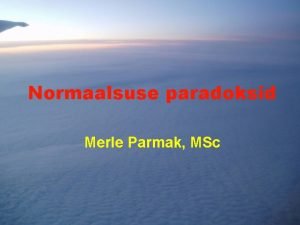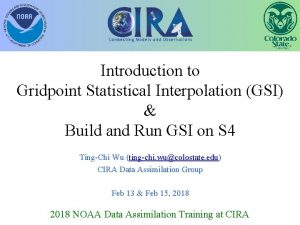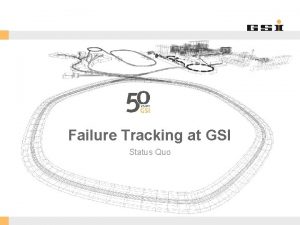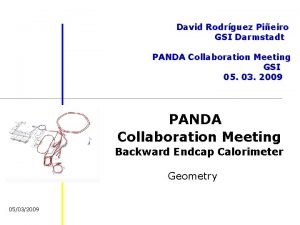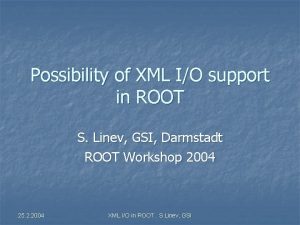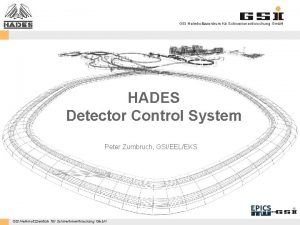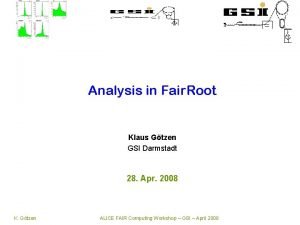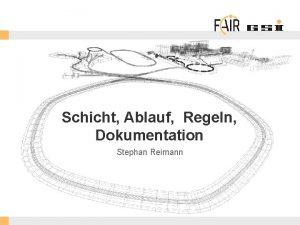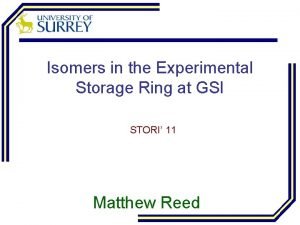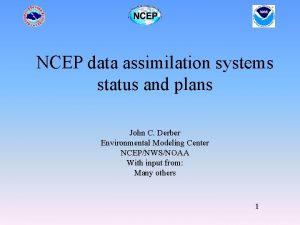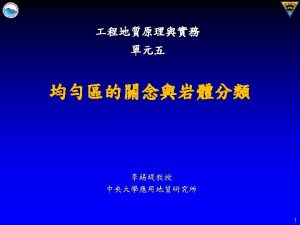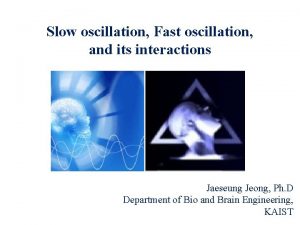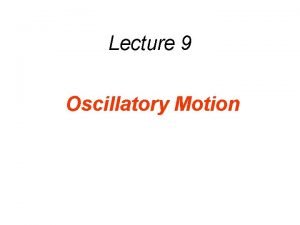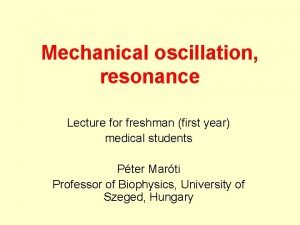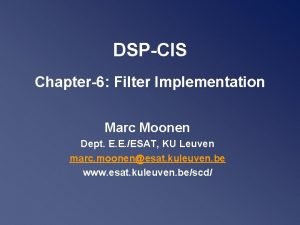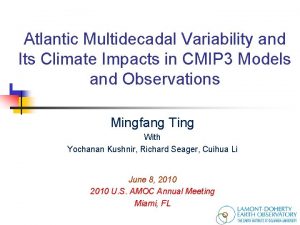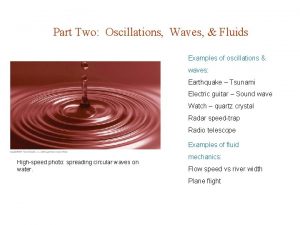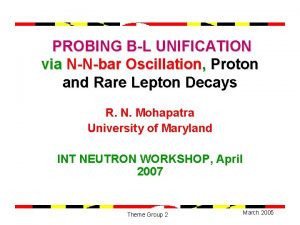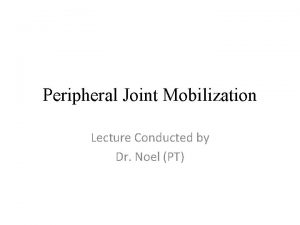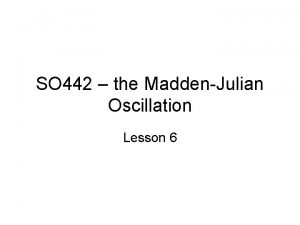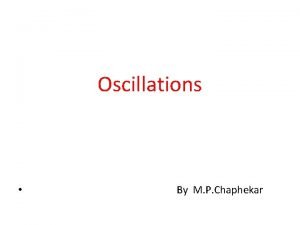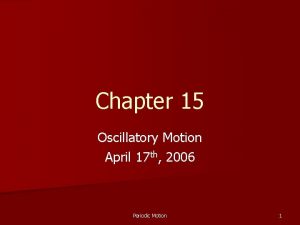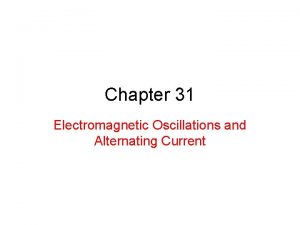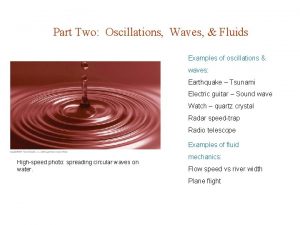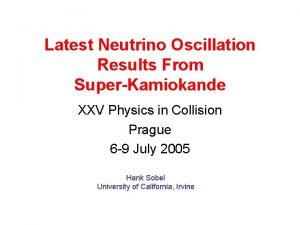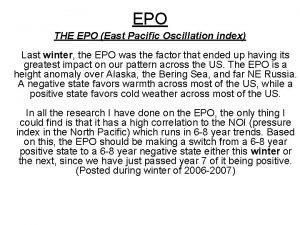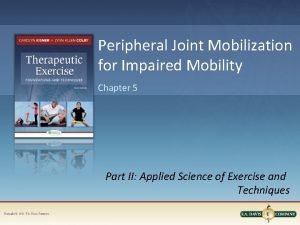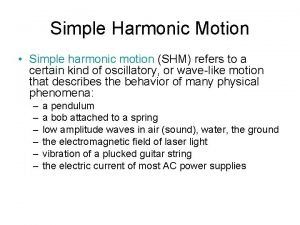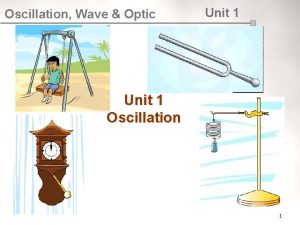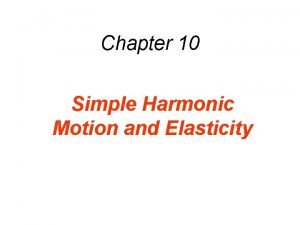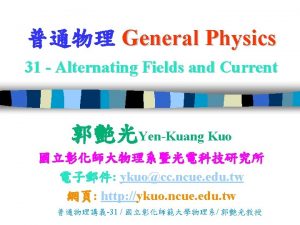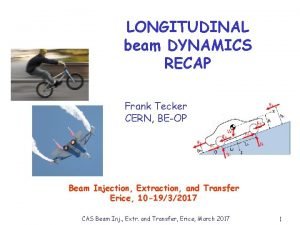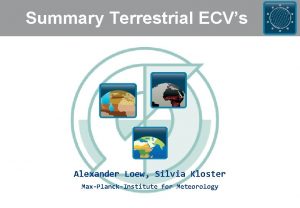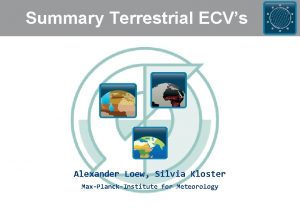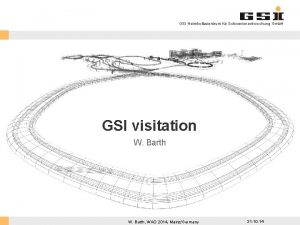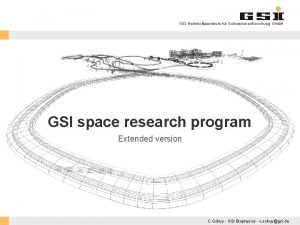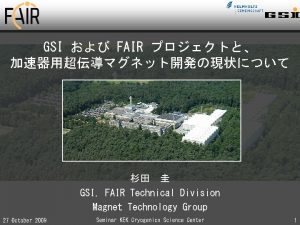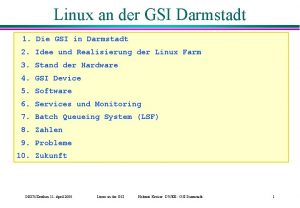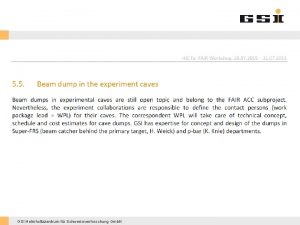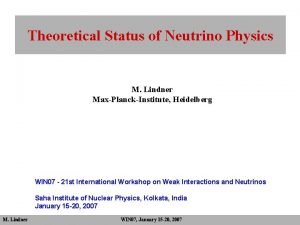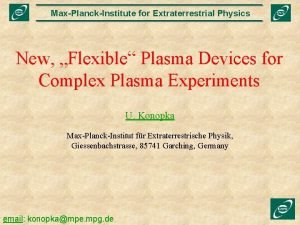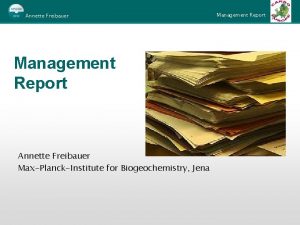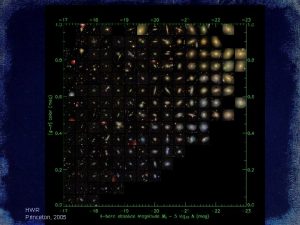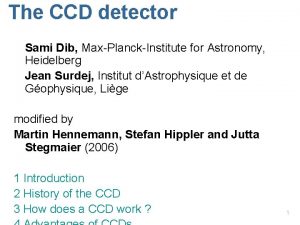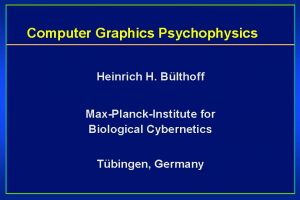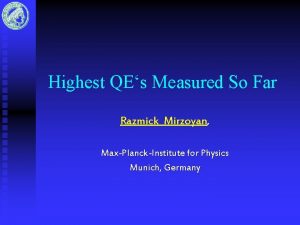The GSI oscillation mystery Alexander Merle MaxPlanckInstitute for











































































































- Slides: 107

The GSI oscillation mystery Alexander Merle Max-Planck-Institute for Nuclear Physics Heidelberg, Germany Based on: AM: Why a splitting in the final state cannot explain the GSI-Oscillations, ar. Xiv: 0907. 3554 H. Kienert, J. Kopp, M. Lindner, AM: The GSI anomaly, J. Phys. Conf. Ser. 136, 022049, 2008, ar. Xiv: 0808. 2389 Erice, 18 th September 2009

Contents: 1. The starting point: What has been observed at GSI 2. Basic thoughts: The superposition principle 3. The easiest formulation: Probability Amplitudes 4. Finally: Conclusions

1. The starting point: What has been observed at GSI

1. The starting point: What has been observed at GSI Litvinov et al: Phys. Lett. B 664, 162 (2008)

1. The starting point: What has been observed at GSI Periodic modulation of the expected exponential law in EC-decays of different highly charged ions (Pm 142 & Pr-140) Litvinov et al: Phys. Lett. B 664, 162 (2008)

1. The starting point: What has been observed at GSI exponential law Litvinov et al: Phys. Lett. B 664, 162 (2008) Periodic modulation of the expected exponential law in EC-decays of different highly charged ions (Pm 142 & Pr-140)

1. The starting point: What has been observed at GSI periodic modulation exponential law Litvinov et al: Phys. Lett. B 664, 162 (2008) Periodic modulation of the expected exponential law in EC-decays of different highly charged ions (Pm 142 & Pr-140)

1. The starting point: What has been observed at GSI periodic modulation exponential law T~7 s Litvinov et al: Phys. Lett. B 664, 162 (2008) Periodic modulation of the expected exponential law in EC-decays of different highly charged ions (Pm 142 & Pr-140)

1. The starting point: What has been observed at GSI Periodic modulation of the expected exponential law in EC-decays of different highly charged ions (Pm 142 & Pr-140) Litvinov et al: Phys. Lett. B 664, 162 (2008)

1. The starting point: What has been observed at GSI Literature on the GSI Anomaly (complete? ): Lipkin, ar. Xiv: 0801. 1465; Litvinov et al. , Phys. Lett. B 664 (2008) 162– 168, ar. Xiv: 0801. 2079; Ivanov et al. , ar. Xiv: 0801. 2121; Giunti, ar. Xiv: 0801. 4639; Ivanov et al. , ar. Xiv: 0804. 1311; Faber, ar. Xiv: 0801. 3262; Walker, Nature 453 N 7197 (2008) 864– 865; Ivanov et al. , ar. Xiv: 0803. 1289; Kleinert & Kienle, ar. Xiv: 0803. 2938; Ivanov et al. , Phys. Rev. Lett. 101 (2008) 182501; Burkhardt et al. , ar. Xiv: 0804. 1099; Peshkin, ar. Xiv: 0804. 4891; Giunti, Phys. Lett. B 665 (2008) 92– 94, ar. Xiv: 0805. 0431; Lipkin, ar. Xiv: 0805. 0435; Vetter et al. , Phys. Lett. B 670 (2008) 196– 199, ar. Xiv: 0807. 0649; Litvinov et al. , ar. Xiv: 0807. 2308; Ivanov et al. , ar. Xiv: 0807. 2750; Faestermann et al. , ar. Xiv: 0807. 3297; Giunti, ar. Xiv: 0807. 3818; Kienert et al. , J. Phys. Conf. Ser. 136 (2008) 022049, ar. Xiv: 0808. 2389; Gal, ar. Xiv: 0809. 1213; Pavlichenkov, Europhys. Lett. 85 (2009) 40008, ar. Xiv: 0810. 2898; Cohen et al. , ar. Xiv: 0810. 4602; Peshkin, ar. Xiv: 0811. 1765; Lambiase et al. , ar. Xiv: 0811. 2302; Giunti, Nucl. Phys. Proc. Suppl. 188 (2009) 43– 45, ar. Xiv: 0812. 1887; Lipkin, ar. Xiv: 0905. 1216; Ivanov et al. , ar. Xiv: 0905. 1904; Giunti, ar. Xiv: 0905. 4620; Faber et al. , ar. Xiv: 0906. 3617; Isakov, ar. Xiv: 0906. 4219; Winckler et al. , ar. Xiv: 0907. 2277; Merle, ar. Xiv: 0907. 3554; Ivanov & Kienle, Phys. Rev. Lett. 103 (2009) 062502, ar. Xiv: 0908. 0877; Flambaum, ar. Xiv: 0908. 2039; Kienle & Ivanov, ar. Xiv: 0909. 1285; Kienle & Ivanov, ar. Xiv: 0909. 1287

2. Basic thoughts: The superposition principle

2. Basic thoughts: The superposition principle Feynman diagrams:

2. Basic thoughts: The superposition principle Feynman diagrams: Neutrino oscillations

2. Basic thoughts: The superposition principle Feynman diagrams: coherent summation Neutrino oscillations

2. Basic thoughts: The superposition principle Feynman diagrams: Electron capture

2. Basic thoughts: The superposition principle Feynman diagrams: incoherent summation Electron capture

2. Basic thoughts: The superposition principle:

2. Basic thoughts: The superposition principle: 1. If different ways lead to the same final state in one particular process, then one has to add the respective partial amplitudes to obtain the total amplitude. The probability of the process to happen is then proportional to the absolute square of this total amplitude (coherent summation). 2. If a reaction leads to physically distinct final states, then one has to add the probabilities for the different processes (incoherent summation).

2. Basic thoughts: The superposition principle: 1. If different ways lead to the same final state in one particular process, then one has to add the respective partial amplitudes to obtain the total amplitude. The probability of the process to happen is then proportional to the absolute square of this total amplitude (coherent summation). 2. If a reaction leads to physically distinct final states, then one has to add the probabilities for the different processes (incoherent summation). Process: e. g. e+e- → μ+μWay: e. g. e+e- → μ+μ- by Z-exchange, but NOT γ or H

2. Basic thoughts: The superposition principle: BUT: Why is the superposition principle true? Can it somehow be derived? Is there an easier (more intuitive) language?

2. Basic thoughts: The superposition principle: BUT: Why is the superposition principle true? Can it somehow be derived? Is there an easier (more intuitive) language? YES!!! → We can use probability amplitudes.

3. The easiest formulation: Probability Amplitudes

3. The easiest formulation: Probability Amplitudes First example: Charged pion decay

3. The easiest formulation: Probability Amplitudes First example: Charged pion decay • • Actually 2 processes: π+→μ+νμ or π+ → e+νe both decay modes are possible

3. The easiest formulation: Probability Amplitudes First example: Charged pion decay • • Actually 2 processes: π+→μ+νμ or π+ → e+νe both decay modes are possible Initial state: 100% charged pion π+ → corresponding total amplitude for this state at t=0:

3. The easiest formulation: Probability Amplitudes First example: Charged pion decay • • Actually 2 processes: π+→μ+νμ or π+ → e+νe both decay modes are possible Initial state: 100% charged pion π+ → corresponding total amplitude for this state at t=0: After some time t>0:

3. The easiest formulation: Probability Amplitudes

3. The easiest formulation: Probability Amplitudes Important points:

3. The easiest formulation: Probability Amplitudes Important points: normalization:

3. The easiest formulation: Probability Amplitudes Important points: normalization: boundary conditions:

3. The easiest formulation: Probability Amplitudes Important points: normalization: boundary conditions: orthogonality: the basis states are clearly distinct → they form an orthogonal basis set for all possible states

3. The easiest formulation: Probability Amplitudes The process of the measurement:

3. The easiest formulation: Probability Amplitudes The process of the measurement: Every detector does nothing else than projecting the time evolved state onto some state

3. The easiest formulation: Probability Amplitudes The process of the measurement: Every detector does nothing else than projecting the time evolved state onto some state → corresponding probability to measure that state:

3. The easiest formulation: Probability Amplitudes The process of the measurement: Every detector does nothing else than projecting the time evolved state onto some state → corresponding probability to measure that state: → the only question is how looks!

3. The easiest formulation: Probability Amplitudes The process of the measurement: Every detector does nothing else than projecting the time evolved state onto some state → corresponding probability to measure that state: → the only question is how → different cases… looks!

3. The easiest formulation: Probability Amplitudes Trivial case: no measurement at all

3. The easiest formulation: Probability Amplitudes Trivial case: no measurement at all no detection → one has gained no information

3. The easiest formulation: Probability Amplitudes Trivial case: no measurement at all no detection → one has gained no information → the projected state is just the time-evolved state itself:

3. The easiest formulation: Probability Amplitudes Trivial case: no measurement at all no detection → one has gained no information → the projected state is just the time-evolved state itself: Of course, the probability for anything to happen is 100%.

3. The easiest formulation: Probability Amplitudes Next step: the detector can only give us the information that the pion has decayed, but we do not know the exact final state

3. The easiest formulation: Probability Amplitudes Next step: the detector can only give us the information that the pion has decayed, but we do not know the exact final state NOTE: This means that the detector cannot distinguish the two states and !!!!

3. The easiest formulation: Probability Amplitudes Next step: the detector can only give us the information that the pion has decayed, but we do not know the exact final state NOTE: This means that the detector cannot distinguish the two states and !!!! We have only gained the information that the initial state is not present anymore:

3. The easiest formulation: Probability Amplitudes Next step: the detector can only give us the information that the pion has decayed, but we do not know the exact final state NOTE: This means that the detector cannot distinguish the two states and !!!! We have only gained the information that the initial state is not present anymore: → projected state (correctly normalized):

3. The easiest formulation: Probability Amplitudes The corresponding probability is:

3. The easiest formulation: Probability Amplitudes The corresponding probability is: → any phase in the absolute value! will drop out due to

3. The easiest formulation: Probability Amplitudes The corresponding probability is: → any phase in the absolute value! will drop out due to → incoherent summation!!!

3. The easiest formulation: Probability Amplitudes One more case: we detect the pion

3. The easiest formulation: Probability Amplitudes One more case: we detect the pion information gained:

3. The easiest formulation: Probability Amplitudes One more case: we detect the pion information gained: projected state:

3. The easiest formulation: Probability Amplitudes One more case: we detect the pion information gained: projected state: corresponding probability:

3. The easiest formulation: Probability Amplitudes One more case: we detect the pion information gained: projected state: corresponding probability: → no oscillation

3. The easiest formulation: Probability Amplitudes Yet another one: we the particular final state

3. The easiest formulation: Probability Amplitudes Yet another one: we the particular final state information gained:

3. The easiest formulation: Probability Amplitudes Yet another one: we the particular final state information gained: probability:

3. The easiest formulation: Probability Amplitudes Yet another one: we the particular final state information gained: probability: → again no oscillation

3. The easiest formulation: Probability Amplitudes Yet another one: we the particular final state information gained: probability: → again no oscillation Question: When do we get oscillations at all? ?

3. The easiest formulation: Probability Amplitudes Yet another one: we the particular final state information gained: probability: → again no oscillation Question: When do we get oscillations at all? ? Answer: If the detector does more than only killing some partial amplitudes.

3. The easiest formulation: Probability Amplitudes Hypothetical example: measurement of a new quantum number, under which neither e+ nor μ+ is an eigenstate, but some superposition of them

3. The easiest formulation: Probability Amplitudes Hypothetical example: measurement of a new quantum number, under which neither e+ nor μ+ is an eigenstate, but some superposition of them possible measured state (example):

3. The easiest formulation: Probability Amplitudes Hypothetical example: measurement of a new quantum number, under which neither e+ nor μ+ is an eigenstate, but some superposition of them possible measured state (example): corresponding probability:

3. The easiest formulation: Probability Amplitudes Hypothetical example: measurement of a new quantum number, under which neither e+ nor μ+ is an eigenstate, but some superposition of them possible measured state (example): corresponding probability: this term can oscillate!

3. The easiest formulation: Probability Amplitudes Second example: Neutrinos

3. The easiest formulation: Probability Amplitudes Second example: Neutrinos Consideration: neutrino that is produced (together with a daughter ion D) in an electron capture decay of the mother ion M

3. The easiest formulation: Probability Amplitudes Second example: Neutrinos Consideration: neutrino that is produced (together with a daughter ion D) in an electron capture decay of the mother ion M time-evolved amplitude (Uei factored out):

3. The easiest formulation: Probability Amplitudes Second example: Neutrinos Consideration: neutrino that is produced (together with a daughter ion D) in an electron capture decay of the mother ion M time-evolved amplitude (Uei factored out): with:

3. The easiest formulation: Probability Amplitudes Again as start: the mother is seen

3. The easiest formulation: Probability Amplitudes Again as start: the mother is seen information:

3. The easiest formulation: Probability Amplitudes Again as start: the mother is seen information: projection:

3. The easiest formulation: Probability Amplitudes Again as start: the mother is seen information: projection: → NO oscillation…

3. The easiest formulation: Probability Amplitudes The GSI-case: we detect the daughter ion, but cannot distinguish the states and

3. The easiest formulation: Probability Amplitudes The GSI-case: we detect the daughter ion, but cannot distinguish the states and only information: the mother is not there anymore

3. The easiest formulation: Probability Amplitudes The GSI-case: we detect the daughter ion, but cannot distinguish the states and only information: the mother is not there anymore normalized state:

3. The easiest formulation: Probability Amplitudes projection:

3. The easiest formulation: Probability Amplitudes projection: → NO OSCILLATION!!!

3. The easiest formulation: Probability Amplitudes projection: → NO OSCILLATION!!! BUT: Why do some authors obtain oscillations?

3. The easiest formulation: Probability Amplitudes The reason is the following: Instead of correctly projecting on the evolved state they project, e. g. , onto an electron neutrino state which is different from the time-evolved one (it is simply not the same state as the one which they claim to be present):

3. The easiest formulation: Probability Amplitudes The reason is the following: Instead of correctly projecting on the evolved state they project, e. g. , onto an electron neutrino state which is different from the time-evolved one (it is simply not the same state as the one which they claim to be present): → What does this change?

3. The easiest formulation: Probability Amplitudes corresponding projection:

3. The easiest formulation: Probability Amplitudes corresponding projection: → The last term does oscillate!

3. The easiest formulation: Probability Amplitudes corresponding projection: → The last term does oscillate! BUT: One has not used the complete information that has been obtained in the experiment! The time that has passed since the production of the mother ion has been neglected!

3. The easiest formulation: Probability Amplitudes corresponding projection: → The last term does oscillate! BUT: One has not used the complete information that has been obtained in the experiment! The time that has passed since the production of the mother ion has been neglected! → This treatment is not complete!

3. The easiest formulation: Probability Amplitudes The remaining question: Does the neutrino that is emitted in the GSI-experiment oscillate?

3. The easiest formulation: Probability Amplitudes The remaining question: Does the neutrino that is emitted in the GSI-experiment oscillate? The obvious answer: Of course!

3. The easiest formulation: Probability Amplitudes The remaining question: Does the neutrino that is emitted in the GSI-experiment oscillate? The obvious answer: Of course! BUT: This can also be shown explicitely!

3. The easiest formulation: Probability Amplitudes The remaining question: Does the neutrino that is emitted in the GSI-experiment oscillate? The obvious answer: Of course! BUT: This can also be shown explicitely! State after detection of the mother: (for simplicity ; does not change anything here)

3. The easiest formulation: Probability Amplitudes Re-phasing this state and measuring the time from t on → new initial state:

3. The easiest formulation: Probability Amplitudes Re-phasing this state and measuring the time from t on → new initial state: Time-evolution:

3. The easiest formulation: Probability Amplitudes Re-phasing this state and measuring the time from t on → new initial state: Time-evolution: with:

3. The easiest formulation: Probability Amplitudes Further complication: Entanglement of the neutrino and the daughter ion.

3. The easiest formulation: Probability Amplitudes Further complication: Entanglement of the neutrino and the daughter ion. • the daughter ion is localized → has to be described by a wave packet • the daughter ion is detected, but not with sufficient kinematical precision to distinguish the different neutrino mass eigenstates → the same like a non-measurement!

3. The easiest formulation: Probability Amplitudes Further complication: Entanglement of the neutrino and the daughter ion. • the daughter ion is localized → has to be described by a wave packet • the daughter ion is detected, but not with sufficient kinematical precision to distinguish the different neutrino mass eigenstates → the same like a non-measurement!

3. The easiest formulation: Probability Amplitudes Further complication: Entanglement of the neutrino and the daughter ion. • the daughter ion is localized → has to be described by a wave packet • the daughter ion is detected, but not with sufficient kinematical precision to distinguish the different neutrino mass eigenstates → the same like a non-measurement! → This is done most easily in the density matrix formalism!

3. The easiest formulation: Probability Amplitudes Density matrix of the time-evolved state: with:

3. The easiest formulation: Probability Amplitudes Density matrix of the time-evolved state: with: Ion not measured → trace over the corresponding states:

3. The easiest formulation: Probability Amplitudes This can, e. g. , be projected onto a μ-neutrino:

3. The easiest formulation: Probability Amplitudes This can, e. g. , be projected onto a μ-neutrino: Corresponding projection operator:

3. The easiest formulation: Probability Amplitudes This can, e. g. , be projected onto a μ-neutrino: Corresponding projection operator: Probability to detect the νμ:

3. The easiest formulation: Probability Amplitudes This can, e. g. , be projected onto a μ-neutrino: Corresponding projection operator: Probability to detect the νμ: Explicit:

3. The easiest formulation: Probability Amplitudes This can, e. g. , be projected onto a μ-neutrino: Corresponding projection operator: Probability to detect the νμ: Explicit: … oscillates!!!

4. Finally: Conclusions • the modification of the exponential decay not in the GSI-experiment cannot be explained by neutrino oscillations • this can be seen most easily in the formulation with probability amplitudes • unfortunately, a satisfying explanation is still missing… … if you have any idea: Phone: +49/6221/516 -817 E-Mail: Alexander. Merle@mpi-hd. mpg. de

4. Finally: Conclusions • the modification of the exponential decay not in the GSI-experiment cannot be explained by neutrino oscillations • this can be seen most easily in the formulation with probability amplitudes • unfortunately, a satisfying explanation is still missing… … if you have any idea: Phone: +49/6221/516 -817 E-Mail: Alexander. Merle@mpi-hd. mpg. de

4. Finally: Conclusions • the modification of the exponential decay not in the GSI-experiment cannot be explained by neutrino oscillations • this can be seen most easily in the formulation with probability amplitudes • unfortunately, a satisfying explanation is still missing… … if you have any idea: Phone: +49/6221/516 -817 E-Mail: Alexander. Merle@mpi-hd. mpg. de

4. Finally: Conclusions • the modification of the exponential decay not in the GSI-experiment cannot be explained by neutrino oscillations • this can be seen most easily in the formulation with probability amplitudes • unfortunately, a satisfying explanation is still missing… … if you have any idea: Phone: +49/6221/516 -817 E-Mail: Alexander. Merle@mpi-hd. mpg. de

4. Finally: Conclusions • the modification of the exponential decay not in the GSI-experiment cannot be explained by neutrino oscillations • this can be seen most easily in the formulation with probability amplitudes • unfortunately, a satisfying explanation is still missing… … if you have any idea: Phone: +49/6221/516 -817 E-Mail: Alexander. Merle@mpi-hd. mpg. de

4. Finally: Conclusions • the modification of the exponential decay not in the GSI-experiment cannot be explained by neutrino oscillations • this can be seen most easily in the formulation with probability amplitudes • unfortunately, a satisfying explanation is still missing… … if you have any idea: Phone: +49/6221/516 -817 E-Mail: Alexander. Merle@mpi-hd. mpg. de

THANK YOU!!!!
 Romantism
Romantism Anankastne isiksus
Anankastne isiksus Merle crawford
Merle crawford Neuroimaging
Neuroimaging Merle femelle
Merle femelle Merle küngas
Merle küngas Dr merle rust
Dr merle rust John fazio marietta college
John fazio marietta college Merle kangal
Merle kangal Merle sepp
Merle sepp Dr merle martin
Dr merle martin Dr merle martin
Dr merle martin A data flow diagram (dfd) is composed of which elements
A data flow diagram (dfd) is composed of which elements Gsi
Gsi Olog gsi
Olog gsi David rodrguez
David rodrguez Gsi parser
Gsi parser Arthus reakció
Arthus reakció Gsi
Gsi Gsi root
Gsi root Gsi calendrier académique
Gsi calendrier académique Pixel gsi
Pixel gsi Gsi panda
Gsi panda Olog gsi
Olog gsi Gsi
Gsi Olog gsi
Olog gsi Calendrier académique unige gsi
Calendrier académique unige gsi Ncep model status
Ncep model status Gsi hoek
Gsi hoek Frequency of oscillation
Frequency of oscillation Slow oscillation
Slow oscillation Two examples of periodic motion
Two examples of periodic motion In the human body
In the human body The mean position of the pendulum is *
The mean position of the pendulum is * Limit cycle oscillation in dsp
Limit cycle oscillation in dsp Amo atlantic multidecadal oscillation
Amo atlantic multidecadal oscillation Renlysis
Renlysis Small amplitude rhythmic oscillations
Small amplitude rhythmic oscillations Forced oscillation
Forced oscillation Oscillation
Oscillation Bifilar oscillation is the example of mcq
Bifilar oscillation is the example of mcq Non-thrust oscillation techniques
Non-thrust oscillation techniques Madden julian oscillation
Madden julian oscillation Damped oscillation
Damped oscillation Damped oscillation
Damped oscillation Electromagnetic oscillations and alternating current
Electromagnetic oscillations and alternating current Oscillation
Oscillation Oscillation
Oscillation Eastern pacific oscillation
Eastern pacific oscillation Peripheral joint mobilization
Peripheral joint mobilization Size separation by sifting
Size separation by sifting Oscillation of spring
Oscillation of spring Units for period of a pendulum
Units for period of a pendulum Damped oscillation
Damped oscillation Disturbance or oscillation
Disturbance or oscillation Rlc oscillation
Rlc oscillation North atlantic oscillation
North atlantic oscillation Oscillation mecanique
Oscillation mecanique What is the amplitude of the oscillation
What is the amplitude of the oscillation Egg för emanuel
Egg för emanuel En lathund för arbete med kontinuitetshantering
En lathund för arbete med kontinuitetshantering Tobinskatten för och nackdelar
Tobinskatten för och nackdelar Atmosfr
Atmosfr Biologiska arvet
Biologiska arvet Programskede byggprocessen
Programskede byggprocessen Presentera för publik crossboss
Presentera för publik crossboss Rbk fuktmätning
Rbk fuktmätning Densitet vatten
Densitet vatten Var 1721 för stormaktssverige
Var 1721 för stormaktssverige Tack för att ni lyssnade bild
Tack för att ni lyssnade bild Tack för att ni har lyssnat
Tack för att ni har lyssnat Vad är referatmarkeringar
Vad är referatmarkeringar Smärtskolan kunskap för livet
Smärtskolan kunskap för livet Karttecken färger
Karttecken färger Fimbrietratt
Fimbrietratt Samlade siffror för tryck
Samlade siffror för tryck Delegerande ledarstil
Delegerande ledarstil Arkimedes princip formel
Arkimedes princip formel Elektronik för barn
Elektronik för barn Personalliggare bygg undantag
Personalliggare bygg undantag Toppslätskivling dos
Toppslätskivling dos Borra hål för knoppar
Borra hål för knoppar Bris för vuxna
Bris för vuxna Mat för idrottare
Mat för idrottare Trög för kemist
Trög för kemist Teckenspråk minoritetsspråk argument
Teckenspråk minoritetsspråk argument Etik och ledarskap etisk kod för chefer
Etik och ledarskap etisk kod för chefer Datorkunskap för nybörjare
Datorkunskap för nybörjare Indikation för kejsarsnitt på moderns önskan
Indikation för kejsarsnitt på moderns önskan Ekologiskt fotavtryck
Ekologiskt fotavtryck Rita perspektiv
Rita perspektiv Formuö
Formuö Redogör för vad psykologi är
Redogör för vad psykologi är Bästa kameran för astrofoto
Bästa kameran för astrofoto Lek med geometriska former
Lek med geometriska former Publik sektor
Publik sektor Lyrik dikt
Lyrik dikt Nyckelkompetenser för livslångt lärande
Nyckelkompetenser för livslångt lärande Handledning reflektionsmodellen
Handledning reflektionsmodellen Vad kallas den mantel som bars av kvinnor i antikens rom
Vad kallas den mantel som bars av kvinnor i antikens rom Vilotidsbok
Vilotidsbok Vilken grundregel finns det för tronföljden i sverige?
Vilken grundregel finns det för tronföljden i sverige? Ministerstyre för och nackdelar
Ministerstyre för och nackdelar Jätte råtta
Jätte råtta Verktyg för automatisering av utbetalningar
Verktyg för automatisering av utbetalningar Tillitsbaserad ledning
Tillitsbaserad ledning Plats för toran ark
Plats för toran ark Vad är hsil
Vad är hsil

